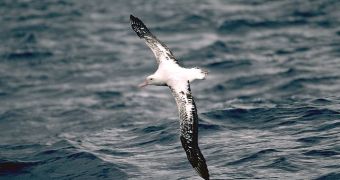The general concept says that birds are almost devoid of olfaction. Anyway, our weak noses would make them shame. But recent researches have showed it's not like that. New World vultures and condors have a smell that would compete with that of the dogs. Experiments made on newly-hatched chickens showed that the little birds could smell water containing a bitter chemical, even ignoring color clues. It seems that birds rather smell a toxic insect than are aware of its warning colors.
It has been proved that albatrosses and petrels, a group of birds also called tubenoses, have well-developed olfactory centers in their brains. A new French-American research published online by the journal "Proceedings of the National Academy of Sciences" is the first to show how individual wandering albatrosses detect food using mainly their sense of smell. These birds can pick up a scent from several kilometers away!
"This is the first time anyone has looked at the odor-tracking behavior of individual birds in the wild using remote techniques," said co-author Gabrielle Nevitt, professor of neurobiology, physiology and behavior at UC Davis.
Wandering albatrosses (Diomedea exulans) make thousands of kilometers across the ocean, surrounding the globe, usually gliding just a few meters above sea level. The huge bird (this is the largest sea bird with a wingspan of 3.7 m (12.3 ft), the absolute record amongst all living birds, and a weight of 12 kg (26 pounds)) feeds mainly on floating carrion, especially squid.
Individuals from the colony of Possession Island (southwestern Indian Ocean) were tagged with GPS receivers tracking their precise position every 10 seconds and stomach temperature assessing, monitoring each meal. When the birds returned to the colony after a foraging session, the gear was recovered and the data downloaded.
The birds appeared to usually fly across the wind, so that they could pick up plumes of scent drifting downwind, while using the best energy-efficient soaring. Rarely, the birds flew straight towards food; but, in 50% of the cases, albatrosses turned upwind or zigzagged into the wind approaching a meal. These behaviors pointed that the birds were using scent plumes rather than visual cues. Upwind, the albatrosses could detect a food source located several kilometers away, far away from the visual horizon.
"Hunting by scent allows the albatross to cover a strip of ocean several miles wide as it flies crosswind," said Nevitt.
Tubenoses do not posses a very keen eyesight, compared to other prey birds, and their eyes rather detect movement on the horizon, allowing them to spot other birds gathering on food-rich spots.

 14 DAY TRIAL //
14 DAY TRIAL //